|
Tenerife Island
Island of Eternal Springtime
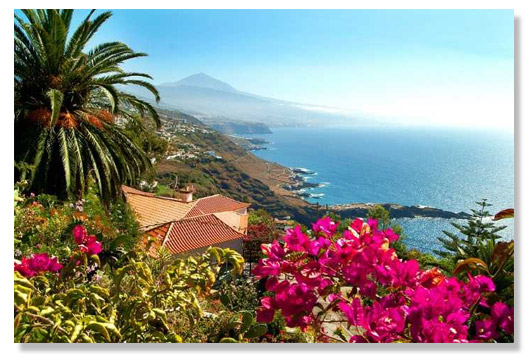
Tenerife is the largest island of the archipelago. There are most
varied landscapes: a mountain range with the mighty volcanic crater
Cañadas del Teide, with a diameter of 20 kilometers, and the 3.718
meters high Teide in its center; extremely fertile valleys with
important cultures of bananas and tomatoes; and a seaside offering as
well beautiful steep coasts as wide beaches of fine sand.


D. JOSÉ
ALBERTO GONZÁLEZ REVERÓN

Don Francisco Enrique Toledo Hernández (Concejal Deportes)

Don Ángel David Herrera González (Concejal Turismo)
The Happy Islands
This paradisiac group of islands, with a preferred climate and
constant temperature through all the year, and splendid beaches of
fine sand, consists of 7 larger islands (Gran Canaria, Fuerteventura,
Lanzarote, Tenerife, La Palma, Gomera, Hierro) and a few smaller ones
(Alegranza, Graciosa, Montaña Clara, Roque del Este, Roque del Oeste
und Lobos). Surprisingly, the landscape of each island is radically
different to the others.
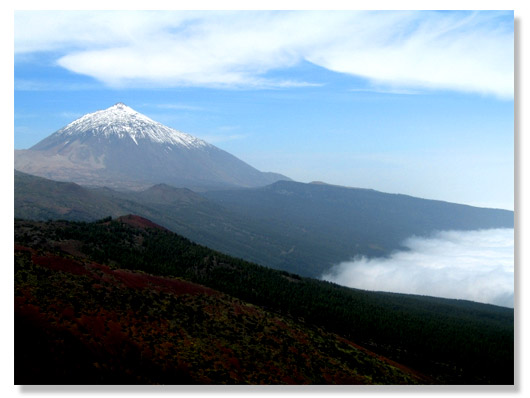
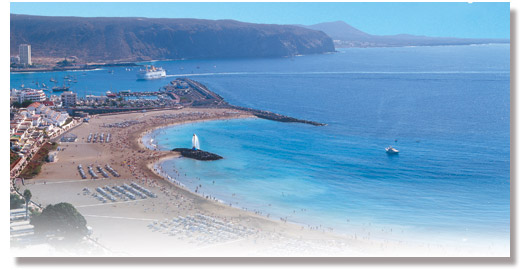
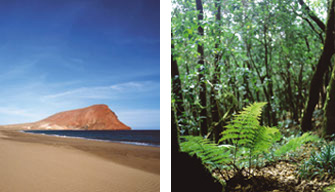
Already Greeks and Romans reported on this archipelago of volcanic
origins, and called it the Happy Islands, Garden of the Hesperides,
Atlantida, ... Some historians suppose that the legendary
continent Atlantis was located here. The islands' original
population, called Guanches, is tall and of white skin.
In 1496 the islands became part of the Spanish kingdom, a short period
of time later the ships of Christopher Columbus stopped here on their
travel to discover the New World.
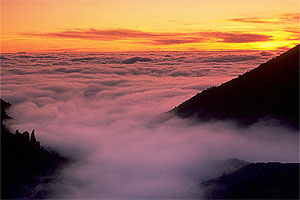
Located 200 km off the
north west African coast, (though a Spanish Autonomous region).
Tenerife is the largest of the seven main Canary Islands. Known for
its diversity, Tenerife is several worlds rolled into one. The sunny
tourist orientated south of the island boasts the majority of the
beaches and virtually continuous sunshine. Daily temperatures range
from typically 24 C in the winter to 34 C in the height of the summer.
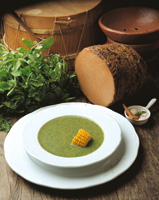
With many attractions
Tenerife's major tourist resorts (Los Cristianos, Las Americas) have several theme parks and attractions
on their doorsteps, including the
Aqua Park (Water Park), Ecological Park Las Aguilas, Tenerife Zoo
and plenty of local entertainment.
Golfer's won't be
disappointed either, Tenerife is home to five championship golf
courses, four of which are located in the south of the Island
including Golf Del Sur, Amarilla Golf, Golf Costa Adeje and Golf Las
Americas. See our golf
page for more information.
The north of the
island gets slightly more rainfall and is consequently far greener and
lush with vegetation and pine forests. A number of popular attractions
are located in the north of the island including the Loro
Park and Zoo of Puerto de La Cruz and the alleged 2000 year old "Dragon
Tree" of Icod de Los Vinos.
More
of the typical Canarian lifestyle has remained in the northern
villages and the beautiful Canarian architecture of La Laguna and La Orotava give a real flavour of Tenerife.
The most dramatic scenes
on the island are in the mountains. Traveling up the slopes which are
covered in Pine forests you rise to the crater of the long extinct and
partially collapsed volcano forming the Las Cañadas Amphitheatre and
National Park with its spectacular lunar landscape and the towering
Mount Teide (3718m) rising from its heart.
Dusted with snow in the
winter Mount Teide is the highest peak in Spain, a cable car takes
visitors to within 100m of the summit (weather permitting) and views
of all seven Canary Islands can be enjoyed on a clear day from the top.
Once you arrive and experience the pleasant all year warm, sunny
climate (which is, not as severe as the Mediterranean) you'll realise
why the Canaries are known as the fortunate islands.
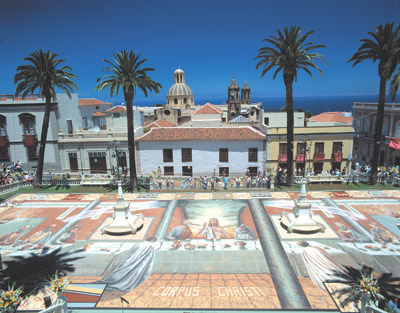
CANARY ISLANDS
Introduction
The Canaries are a seething mass of oiled flesh, and offer the worst
of mass tourism: concreted shorelines, tacky apartment blocks and bars
where you can pretend you've never left home; but they also offer some
of the best beaches within easy escape from a snowy European winter.
Luckily, it's not all mass tourism. Beyond the mega resorts you can
still find tiny fishing villages, whitewashed hamlets perched on
hilltops and even a few wild places within earshot of the dull roar of
a volcano or with mist dripping through primeval forests.
Full country name:
Canary Islands
Area: 7,447 sq km
Population: 1.84 million
People: Spanish, North African, small
Latin American and northern European communities
Language: Spanish; Castilian
Religion: Roman Catholic
Government: Spanish autonomous region
Head of State: King Juan Carlos I
Head of Government: Prime Minister Jose
Luis Rodriguez Zapatero

GDP: US$219 million
GDP per capita: US$14,000
Annual Growth: 3.5%
Inflation: 4.3%
Major Industries: Tourism.
Major Trading Partners: France, Germany,
Italy
Member of EU: Yes
Facts for the Traveler
Visas:
Spain (of which the Canaries are a part) along with Belgium, France,
Germany, Luxembourg, the Netherlands and Portugal, forms part of the
border-free travel zone known as the Schengen Area. US, Canadian,
Australian, New Zealand and Israeli citizens are among those who may
enter the Canary Islands as tourists without a visa and stay up to 90
days. EU passport holders can come and go as they please.
Time Zone: GMT/UTC +1
Dialling Code: 34
Electricity: 220V ,50Hz
Weights & measures: Metric
When
to Go
Go
whenever - the weather is great year-round. December to March are the
islands' busiest months, bringing the thickest crowds and higher
prices. Being winter, the weather is also slightly cooler. The best
value on airfares is offered from November to mid-December and even
better, April to May (with the exception of the Easter rush).
Events
Like many of their mainland cousins, Canarios kick back and celebrate
at plenty of fiestas and ferias (fairs) throughout the year.
Carnaval in February/March is the wildest time, and brings
several weeks of parades, fancy dress and general good times across
the islands. In Santa Cruz de Tenerife, the party rivals the Rio
Carnaval. From 21 to 30 June, the Bajada de La Virgen de las
Nieves is the premier religious festival on Isla de la Palma,
but is held only every five years (2005, 2010). The most important
religious celebration held on Gran Canaria is the Fiesta de la
Virgen del Pino, and festivities last for two weeks,
culminating on 6 to 8 September.
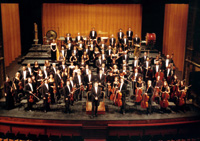
Las
Palmas de Gran Canaria hosts several important arts festivals,
including the Festival de Música de Canarias (January);
the Festival de Opera (February-March); the
Festival de Ballet y Danza (May); and the Festival
Internacional de Cine, an international film festival held
every two years in October and November. If that's not enough, the
Encuentro Teatral Tres Continentes draws theatre companies
from Europe, Latin America and Africa to Agüimes (Gran Canaria) in
September.
Money & Costs
Currency: Euro
(€)
Relative Costs:
Meals
·
Budget: US$3-5
·
Mid-range: US$5-20
·
High: US$20-40
·
Deluxe: US$40+
Lodging
·
Budget: US$20-30
·
Mid-range: US$30-80
·
High: US$80-100
·
Deluxe: US$100+
Daily living costs are marginally lower than
those in Europe, and budget travellers could manage on about US$40 a
day. You would have to share rooms at the cheapest pensiones
and apartments, eat only one restaurant meal a day (a cheap one), and
get around slowly on foot, local bus and ferry. Flying soon burns a
hole in your pocket. A more comfortable budget would be US$60-100 a
day, which would allow you to move up a little in the accommodation
stakes, eat more comfortably and possibly include a few days' car
hire. The sky's the limit if you have no budget; you can spend US$30
or more on a halfway decent meal, stay in international hotels, fly
everywhere between islands, go on tours and then eat baked beans for
the rest of the year.
You're best off carrying your money as
travellers cheques and plastic, with plastic probably nudging ahead as
the best way to spend. There are plenty of exchange offices throughout
the islands, and most hard currencies are widely accepted, although
the New Zealand dollar could pose problems. It's not a bad idea to get
your cheques in large amounts to save on per-cheque commission
charges. Major brands of credit cards are widely accepted, and if you
can, try to take more than one card, and try to keep them separate in
case of theft or loss.
Tipping is a matter of personal choice in
restaurants. If you're satisfied with the service, leave some small
change - 5% is usually plenty. The only places you may be able to
bargain are markets, although even there fixed prices are generally
the rule. You may be able to bargain in some cheap hotels, where you
might be able to negotiate a price for a long stay.
Attractions
Las Palmas de Gran Canaria
The largest town in the Canaries, Las Palmas has an unmistakably
big-city feel. It sits on the northeastern tip of Gran Canaria and has
begun swallowing up the small island of La Isleta. The city hugs the
coast up a series of long boulevards to the bustling Santa Catalina
and Puerto de la Luz.
The Catedral de Santa Ana is the city's main place of worship and took
350 years to complete. Nearby, the Museo Diocesano, set on two levels
around the Patio de los Naranjos, contains the standard collection of
religious art and memorabilia, including old manuscripts and wooden
sculptures.
Isla de Lanzarote
It
hardly ever rains on Lanzarote, so all the water you drink and wash in
is likely to be desalinated sea water. It's an incredibly arid place,
and at first glance may not appear to offer much, but UNESCO has
declared the entire island a biosphere reserve.
The volcanic terrain is bizarre, and it's worth taking your time to
move around the island and away from the three main resorts. It's not
worth spending much time in the capital, Arrecife, as Cueva de los
Verdes and Jameos del Agua are probably the main attractions.
Parque Nacional de Garajonay
The island of La Gomera's outstanding natural attraction is the
ancient laurisilva (laurel forest) at the centre of the Parque
National de Garajonay. Cool Atlantic trade winds clash with warmer
breezes, creating a constant ebb and flow of mist through the forest,
made dark by the dense canopy.
Forests like this grew over most of the Mediterranean until the last
ice age. Most visitors head for the Alto de Garajonay, the island's
tallest peak, from where you are rewarded with great views. Another
good stop is La Laguna Grande just off the highway.
Playa del Inglés & Maspalomas
This is the party part of the Canaries, sun-starved snowbirds fly
south for year-round sun, swimming, sex and such. From lager louts to
Swedish sun-worshippers, they're all here within a couple of
kilometres of suntan oil-soaked sand and tour operator-infested city
blocks.
When you tire of the beach scene, try a theme parks or three: Palmitos
Park, a subtropical oasis crammed with exotic flora and 1500 species
of birds; Mundo Aborigen, with about 100 model Guanches posed to look
how the real thing used to; or Sioux City, with good and bad guys
shootin' each other up.
Santa Cruz de Tenerife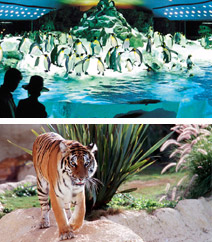
Santa Cruz de Tenerife is one of the busiest ports in Spain, and its
long harbour sees countless container ships, cruise liners and a host
of inter-island ferries and jetfoils. Everything of interest lies
within about 1km (0.6mi) of Plaza España.
The town has three museums - the Museo de la Naturaleza y El Hombre is
easily the most interesting with its Guanche mummies and skulls, and
its natural sciences section. The Museo de Bellas Artes has a lovely
fine art collection and the Museo Militar de Almeyda specialises in
the elements of war.
Off
the Beaten Track
Betancuria
In 1405 Jean de Béthencourt gave his name,
mutated to Betancuria, to a tiny settlement consisting of his house
and a chapel. The island's proximity to the North African coast meant
that pirates overcame the town's natural defences several times and
sacked it, and only 600 people live there now.
A couple of kilometres north of town is the
Mirador Morro Velosa, which offers mesmerising views across the
island's weird, barren landscape. South of town is the Vega del Río de
Palmas, a dry watercourse that is nevertheless wet enough below the
surface to keep a stand of palms going.
Isla de El Hierro
El Hierro is about as far as you can get from
the tourist hordes, bars and oil-streaked, cavorting naked Swedes. It
is a rural island largely untouched by tourism, and the green farmland
divided by rough stone walls is more reminiscent of the Irish
countryside than a subtropical beach resort.
The capital is Valverde, the only Canaries
capital not on the coast, and it's a lovely, red-roofed town of about
1600. The walking is good on the island, and you can pass through
hamlets such as Echedo, in the heart of wine-growing territory, or the
cheese-producing village of Isora.
Parque Nacional de la Caldera de Taburiente
This was the fourth national park declared in
Spain in 1954. Its massive wall of volcanic rock is about 10km (6mi)
in diameter, and its only real opening, the aptly named Barranco de
las Angustias (Gorge of Fear) lies to the southwest. The walls drop
away in some places to as much as 2000m (6560ft).
The park's lower levels are covered by dense
thickets of Canary Island pine. Landslides are not infrequent as the
forces of erosion are hard at work. Although calderas are volcanic
craters, Caldera de Taburiente is not a crater but the result of slow
excavation by erosion over millions of years.
Santa Cruz de la Palma
Most points of interest in compact Santa Cruz
are within a few blocks of the waterfront Avenida Marítima. Beautiful,
brightly painted old houses, some with wonderful balconies, line the
waterfront. The heart of the old town, the prettiest part of it,
surrounds Plaza España and Calle de O'Daly.
On O'Daly you'll find the 17th-century Palacio
de Salazar, now home to the tourist office. Along both sides of the
street centuries-old Canarian mansions house a mix of shops, bars and
offices. Behind the Plaza Constitución is the modest 16th-century
chapel Ermita de Nuestra Señora de la Luz.
Activities
The most in-your-face activity in the islands is beach-lazing,
but you don't have to look hard for more active pastimes. Mountain
bikes are readily available, and the islands lend themselves to
cycling. Plenty of tracks in the country are fine for hiking,
and by the coast conditions for surfing and windsurfing
are excellent. For windsurfers, the Bahía de Pozo Izquierdo is the
best beach on Gran Canaria, which is the windiest of all the islands.
The swimming is generally better in summer, as the Atlantic has
powerful swells in winter. Go snorkelling or scuba diving
and you might see rays, grouper, barracuda, turtles, tropical fish and
the occasional shark. Deep sea fishing and sailing are
good for those with a little more money to spend, and the fishing off
Gran Canaria is excellent.
History
The islands are estimated to be 30 million years old, which is
relatively young by geological standards. Their existence was known,
or at least postulated, in ancient times.
Carbon dating has placed the earliest settlement at around 200 BC,
although earlier settlement is possible. It was long suggested that
Cro-Magnon, the Paleolithic predecessor to Homo sapiens, first
inhabited the Canaries, although that is not now generally thought to
be the case. One clue, apart from the ancient skulls of the original
inhabitants, is the conquering Europeans' 15th-century descriptions of
locals. Mainly on Tenerife, they found tall and powerfully built
people with blue eyes and long fair hair. These people called
themselves Guanches, from guan, 'man', and che or
achinch meaning 'white mountain', in reference to the snow-capped
Teide volcano. Suggestions for the origins of the Guanches have ranged
from Celtic immigrants from mainland Spain or Portugal, to Norse
invaders, supplying a possible explanation for the blonde hair and
blue eyes. Berber immigrants from nearby Saharan Africa almost
certainly inhabited some of the eastern islands, and place names bear
a striking resemblance to Berber tribal languages. Occasionally blue
eyes and fair hair crop up among the Berbers as well, so the Guanches'
origin is still open to question.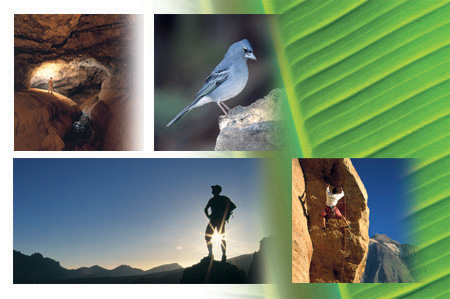
By
the time the Europeans began looking around the islands in the Middle
Ages, they were inhabited by a variety of tribes often hostile to one
another. Tenerife alone was divided into no fewer than nine tiny
fiefdoms. The Guanches relied on limited farming, herding, hunting and
gathering, and the majority of them lived in caves. The first vaguely
reliable account of a landing by Europeans comes in the late 13th or
early 14th century, when the Genoese captain Lanzarotto Malocello came
across the island that would later bear a version of his name:
Lanzarote. A host of dreamers looking for the legendary Río de Oro
(River of Gold) that many thought flowed into the Atlantic at about
the same latitude as the Canaries, missionaries bent on rescuing
souls, and slavers looking to fill their holds passed by or came to
stay, but it took a Portuguese-Italian mission of 1341 to finally put
the Canaries on the map.
The first Europeans to attempt to conquer the Guanches were Normans
from France in 1402, and the final campaigns more or less ended in
1495 under a Galician soldier of fortune. The century saw massacres,
warfare and Guanches sold off wholesale into slavery, and within
another century their language had all but disappeared, and the
survivors had intermarried with the invaders, converted to
Christianity and taken Spanish names.
Spain's control of the islands did not go unchallenged. First Moroccan
troops occupied Lanzarote in 1569 and 1586, then Sir Francis Drake
tried a little gunboat diplomacy off Las Palmas in 1595. A Dutch fleet
reduced Las Palmas to rubble in 1599, then in 1657 the Brits under
Admiral Robert Blake defeated the Spanish at Tenerife. The score:
Spanish treasure fleet annihilated, British lose one ship.
Spain managed to hang on though, and the Canaries were declared a
province of Spain in 1821. Santa Cruz de Tenerife was declared the
official capital, adding fuel to the already low-level bickering
between Tenerife and Gran Canaria. The inhabitants of Gran Canaria
demanded that the province be split into two, which it was for a short
and unsuccessful period in the 1840s. Several agricultural commodities
followed boom-bust cycles on the islands: sugar cane, wine and then
cochineal for making dyes all had their day, followed by bananas and
to a lesser extent tomatoes and potatoes.
The WWI British maritime blockade of Europe destroyed the banana
trade, and Canarios voted with their feet and fled the poverty at home
in droves for a new life in Latin America.
The short period of hope that followed WWI was dashed when Spain fell
into the chaos of civil war in 1936. In March of that year, the
Spanish Republic transferred General Franco to the Canaries, under the
(well founded) suspicion that he was involved in a plot to overthrow
the government. Franco seized the islands in July, then flew to
Morocco to continue the fight, leaving the Nationalists to round up
Republican sympathisers in the islands.
The Canaries suffered from the same post-war misery as Spain, and
again thousands fled, although this time clandestinely and mainly to
Venezuela. In the 1950s 16,000 left the country; a third of those who
attempted the journey perished in leaky boats. By the early '60s,
Franco decided to throw the country's doors open to sun-starved
tourists. The latest and greatest boom - and the one that transformed
the economy so miraculously and parts of the islands, well, less so -
began. Millions of sun-seeking hedonists now flock to the islands
annually.
The Coalición Canaria played a large role in the right wing Partido
Popular's win at the general elections in 1996. They have lent their
support to the government under the condition that consideration be
given first and foremost to their needs, putting the interests of the
islands before any national considerations.
Having been granted the status of a comunidad autónoma
(autonomous region) in 1982, in recent times the Canaries have been
leveraging their political strength. The islands made a rare entry
into global headlines in April 2004 when 14 immigrants from
sub-Saharan Africa drowned when their boat collided with another in
waters near the Canaries.
Culture
The symbol of the Canarios' musical heritage is the timple, a
ukelele-style instrument possibly introduced into the islands by
Berber slaves shipped in for farm work by the Norman invaders early in
the 15th century. The timple has travelled widely and been
incorporated into the musical repertoire of Cuba and other Latin
American countries. At traditional fiestas the instrument will
accompany dances such as the isa and folía and, if
you're lucky, the tajaraste - the only dance said to have been
passed down from the Guanches.
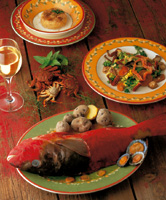
The Guanches left cave paintings dating from the 13th and 14th
centuries scattered around the islands, particularly in the cuevas
(caves) of Gáldar, Belmaco, Parque Cultural La Zarza, and the Los
Letreros. They mostly depict human and animal figures. It took
centuries after the Spanish conquest for any artists of note to appear
on the scene, but foremost among them was Gaspar de Quevedo, who
painted in the 17th century. More notables from later centuries
include Valentín Sanz Carta, who depicted the land in his 19th century
works, and Manuel González Méndez, who was the islands' main exponent
of Impressionism in the early 20th century. All the great currents of
European art washed up on the Canaries. Among the abstract artists,
César Manrique enjoyed a degree of international recognition. He is
revered around the archipelago for his imaginative works and his
tireless efforts to preserve Canary culture under the onslaught of
mass tourism.
The Guanches do not appear to have known writing, but Italian
historian Leonardo Torriani translated many of their ballads. Benito
Pérez Galdós (1843-1920) is considered by some to be the greatest
Spanish novelist since Cervantes, and he grew up in Las Palmas and
moved to Madrid in 1862. Isaac de Vega has been one of the Canaries'
most outstanding novelists this century, and his novel Fetasa
is a disturbing study of alienation and solitude.
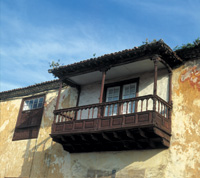
Spanish, or more precisely, Castilian, is the official language of the
Canaries, and only place names from Guanche survive. Roman Catholicism
gained an early foothold in the islands, and although many Canarios'
religious faith may be doubtful, the Church still plays an important
role in people's lives. Most Canarios are baptised and have church
weddings and funerals, although less than 50% regularly turn up for
Sunday service.
People normally socialise in the streets, and dinner parties and
gatherings in people's homes are the exception rather than the rule.
Canarios enjoy Mediterranean hours, with a late morning start, a long
break for lunch, siesta and family gathering from around 2pm to 5pm,
and then a few more hours work before dining and more socialising well
into the night.
Environment
Slightly smaller than the French Mediterranean island of Corsica, the
Canary Islands consist of seven main islands and six islets, which are
the tips of a vast volcanic mountain range lying beneath the Atlantic
Ocean. Their nearest neighbour is Morocco, about 95km (59mi) east of
Fuerteventura. The islands pack a huge variety of landscapes into a
small area, including weird volcanic plateaus, cloud forest wreathed
in mist, cliffs lashed by Atlantic squalls and green fields growing
grapes and olives. Not to mention the block after block of apartments,
international hotels and beaches coated in wall to wall holiday makers
that are now as much a part of the Canaries as the natural
attractions.
The volcanoes that form the islands' backbone saw the light of day at
about the time the Atlas Mountains were formed in North Africa
millions of years ago. The highest volcano, El Teide (3718m/12,195ft)
is Spain's tallest peak and the third-tallest volcano in the world
after two in Hawaii. All the volcanic activity has ensured that the
soil is very fertile, but there are no rivers and the islands have
been periodically plagued by water shortages. Most of the drinking
water on some islands comes straight from desalination plants.
The varied altitude and rich volcanic soils have combined to create
several biological treasures in the Canaries. About half of the
islands' 2000 plant species are endemic, including the Canary Island
palm, the Canary pine and the dragon tree, an ancient survivor that
thrived before the last ice age. Microclimates in the islands allow
for great variation in vegetation, from the Unesco-declared World
Heritage sites of laurisilva, with lichen-covered laurels,
holly, linden and heather, to the dry scrublands and semi-desert areas
where saltbush, palms and the rare, cactus-like cardón de Jandía
grow. The most interesting indigenous animal is the lagarto del Salmor,
which grows up to 45cm (17in) long and is particularly ugly lizard
found only on El Hierro. There are more than 200 species of bird,
although many are no more than migratory visitors. The canary, of
course, is found in the wilds, but don't expect the dainty caged
varieties: the wild cousin of Continental Frilleds and Gloster Fancies
is a dirty brown colour.
Theoretically, the Canary Islands are one of the most extensively
protected territories in Europe, with 42% of the the land mass falling
under some category of park land. The four national parks are the
Parque Nacional de las Cañadas del Teide, with El Teide volcano as its
centrepiece; the Parque Nacional de Garajonay, with a beautiful
ancient rainforest; the Parque Nacional de Timanfaya, with active
volcanoes; and Parque Nacional de la Caldera de Taburiente, which
encloses an enormous eroded rock cauldron. The parques naturales
form the second most extensive tier of parks, but they've generally
seen a greater level of human intrusion, such as villages, farms and
roads, than the national parks.
The Canaries bask in an eternal-spring climate, with mean temperatures
ranging from 18°C (64°F) in winter to 24°C (75°F) in summer. On a hot
day at the beach, it can still be pleasantly cool if you get up into
the mountains, and you'll definitely need warm clothes if you reach
any high altitudes during the winter. Except for Lanzarote and
Fuerteventura, the northern side of the islands is sub-tropical, while
the south, including the first two mentioned islands, is drier and
slightly warmer. There is not much rain except on parts of the
windswept northern coasts, and what there is tends to fall on the
northern side of the more mountainous islands. The flatter islands,
with no mountains to trap rain clouds, receive hardly a drop of rain.
On occasion, especially in summer, the sirocco (the hot wind
from the Sahara) blows in from Africa, turning day into twilight and
coating everything with grime. It's at its worst in the eastern
islands, and is known locally as the kalima.
Getting There & Away
All the islands have airports. Gran Canaria, Tenerife and Lanzarote
accept the bulk of the international flights and those from mainland
Spain. You can fly to the Canaries from most European cities, with or
without stopovers in Spain. If you are flying from North America,
flights usually go to Madrid, where you pick up a connecting flight.
Your best bet may be to fly to London, or even Munich, and pick up a
cheap flight from a discount travel agent there.
There is a weekly ferry from the southern Spanish port of Cádiz.
Departure tax is factored into the cost of your ticket so you won't
have to worry about last-minute cash searches as you prepare to fly
home.
Getting Around
Binter is the local airline and although flying is not cheap, it is
infinitely faster than the alternatives of bus and ferry. The islands
are connected by roll-on roll-off ferries, hydrofoils and jetfoils.
Buses are known as guaguas, which will bring a smile of
recognition to anyone who has travelled in Latin America. Each island
has its own service, which will get you to most of the main
destinations, but the number of runs is disappointing, especially on
the smaller, less populated islands where most people have their own
wheels. All the big rental companies are represented in the Canaries,
and there are also local operators. It may be worth booking a car in
advance if you intend to stay for a reasonable length of time; if you
decide to rent a car after you arrive, shop around to avoid the
sharks. You can also take taxis wherever you go, but that is
definitely the pricier alternative.
Further Reading
·
In Le Canaarien, Alexander Cioranescu
has collected texts by the islands' conquerors, Jean de Béthencourt
and Gadifer de la Salle.
·
The Guanches - Survivors and their
Descendants, by José Luis Concepción, looks at the fate of the
islands' first inhabitants.
·
La Biblioteca Canaria has published El Arte
en Canarias, a comprehensive review of art and architecture in the
islands.
·
Flowers in the Canary Islands by Juan
Alberto Rodríguez Pérez, is available in English and German and is one
of the most comprehensive books on the subject.
·
Pleasures of the Canary Islands: Wine, Food,
Beauty, Mystery, by Ann and Larry Walker, is one of the few
introductions to Canary Island food in English. More portable than the
above book, but available only in the Canary Islands, is The Best
of Canary Island Cooking, written by various authors.
·
A Birdwatchers' Guide to the Canary Islands,
by Tony Clarke and David Collins, is the perfect companion for a pair
of skyward-pointed binoculars.
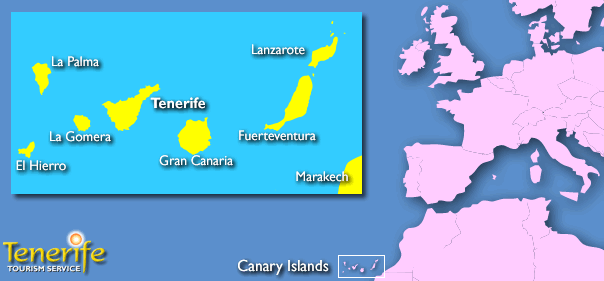
NOTE:
All music that you can ear in this website is
composed and played by
José Ledesma in his CD "Etno Chill Out de Canarias".
Jose
Ledesma
is extremely successful
in many different fields of human endeavor. He produces incredible
music that combines his love and respect of the past and its popular
island traditions the sounds of his country and his people fused to
the anticipation of all that the future may promise: www.joseledesma.com/musica

www.palomasdeblanco.com
|
